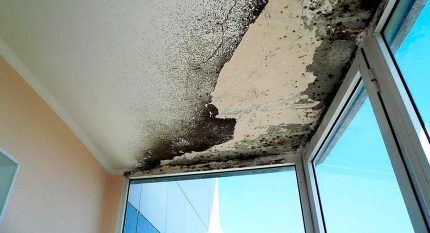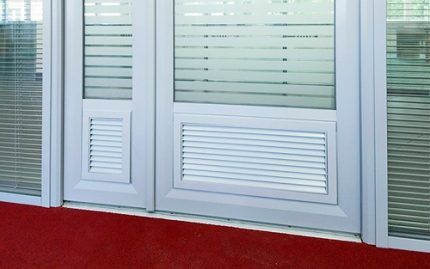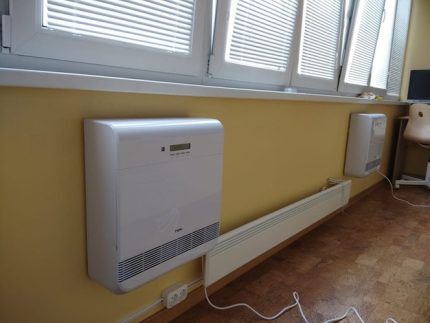Exhaust ventilation on balconies and loggias: options for organizing ventilation
Glazing of balconies and loggias is a great opportunity to get another, albeit not very large, warm and cozy room.Agree that any isolated room needs ventilation, so exhaust ventilation on the balcony must be installed without fail.
Without high-quality ventilation, moisture will begin to accumulate on the glass of double-glazed windows, and dampness in the room will be felt more and more. If the issue is not resolved radically, this can lead to the appearance of mold, and this is a direct threat to the health of the apartment’s inhabitants.
We will talk about the rules for installing ventilation and consider all the intricacies of performing the work. Let's get acquainted with the options for creating ventilation systems and dwell in detail on the implementation of projects. You will see that you don’t need any special equipment or technology to install ventilation, and all the work can be easily done yourself.
The content of the article:
In what cases is ventilation required on the balcony?
Initially, the balcony and loggia were an open structure used for growing plants or drying clothes. The glazing trend came later, but since the windows had wooden frames, the structure of the material allowed natural ventilation.
The situation changed with the advent of plastic double-glazed windows, which ensure almost complete tightness of the room.

The benefits of such windows are obvious:
- High thermal insulation properties;
- High sound insulation properties;
- Tightness;
- Long service life.
But along with a number of advantages, the problem of condensation arises, which inevitably has to be solved. Partially, the problem of excess moisture can be solved with high-quality insulation, but even this effective work does not eliminate the need for a ventilation system.
Causes of condensation
Warm humid air on a balcony or loggia, when it comes into contact with the cold surfaces of partitions or double-glazed windows, quickly reaches the dew point. As a result, the resulting steam settles on the walls and glass.

First of all, condensation forms on insufficiently insulated surfaces. But there is no escape from excess moisture even with high-quality insulation. Moisture will still continue to accumulate, albeit not as quickly. To eliminate it, you will need a ventilation system.
Signs indicating the need for ventilation
Any closed balcony or loggia (if high-quality glazing is installed) needs a ventilation device.
The main signs indicating the need to improve air exchange:
- Increased humidity, condensation formation;
- Fungal formation black mold;
- Perceptible mustiness and stuffiness in the air;
- Rotting of wooden structures or natural fabric materials.
The absence of the problems described is not yet a reason to refuse ventilation on the balcony.
A ventilation system is necessary if:
- The balcony or loggia is glazed using modern double-glazed windows.
- The glazed unheated space is located on the top or first floor, which increases the risk of dampness.
- The room is used for drying things or storing food.
- Things that deteriorate when exposed to moisture are stored indoors.
- Lack of regular ventilation by opening windows.
Other troubles may also arise - when mold appears, through drying clothes or objects it can get into other rooms of the apartment.
Types of exhaust ventilation for balconies and loggias
When organizing a ventilation system on a loggia or balcony with double-glazed windows, it is usually enough to ensure air flow. However, in some cases it would be appropriate to install a hood.
Ventilation systems can be classified according to two main criteria:
- Air flow direction – air can be removed or supplied;
- The method of air exchange is natural ventilation or forced ventilation using fans.
Let's look at the operating principle of each system and look at the installation diagrams in more detail.
Ventilation in the direction of air flow
As a rule, to organize ventilation of a balcony or loggia, it is enough to ensure air flow.
An air removal system may be required in the following cases:
- An electric grill or smokehouse is installed in the room;
- The premises are used for smoking;
- Presence of animals;
- Growing plants sensitive to oxygen deficiency.
When installing only supply ventilation, the air will be removed through bathroom hood or kitchens.
Ventilation by air exchange method
Depending on the method of air exchange, natural and forced ventilation are distinguished. In some cases, a mixed scheme can be used, when air is supplied forcibly and air is removed naturally.
Natural ventilation of balconies and loggias
With natural ventilation, both air supply and exhaust are provided through vents without the use of fans. This system is distinguished by its simplicity; its creation does not require any electrical equipment.

Air flow can be ensured as follows:
- Keep windows open. This method is acceptable in the warm season when there is no dust or noise on the street.
- Installation of windows with micro-ventilation function. A tiny flap provides air flow, but prevents insects from entering the room and significantly reduces sound volume.
- Installation of a window valve, which ensures air flow even when the window is closed. The disadvantage is that such a valve can only move a small amount of air, so multiple valves may need to be installed.
- Installation of a wall valve.The essence is the same as with a window valve, the only difference being that the valve is installed in the fence. Wall valve has a larger cross-section, therefore allowing a larger volume of air to pass through.
The air is discharged through the room adjacent to the balcony.

You can ensure the flow of air from a balcony or loggia into the room as follows:
- Installation of a transfer grille in the balcony door;
- Installation of the valve in a balcony window or door;
- Installation of a wall valve in the wall between the loggia and the room;
- An open balcony door or a gap under the door.
Along with the advantages associated with ease of installation and maintenance, natural ventilation has significant disadvantages, since the performance of the system largely depends on weather conditions, the performance of the ventilation ducts, and there is no way to regulate the air exchange rate.
Forced ventilation of balconies and loggias
Most often, forced ventilation of the balcony is done by supply air, but the option is also possible supply and exhaust system. The disadvantage of the latter is that if installed incorrectly, fresh air will remain only within the balcony and loggia, and will not enter the room.
The main advantages of forced ventilation are that its operation is not affected by weather conditions, and the air exchange rate is determined by the power of the fan used.
When installing supply ventilation, the fan is mounted in the wall, but it is also possible to install it in a window.Since the balcony and loggia have a relatively small area, to ensure efficient operation of the ventilation system it will be enough to install a fan with a diameter of 10 cm.

You can increase the comfort of the supply system by equipping the fan with a humidity sensor. If you have several fan speeds, you can speed up the air exchange process, which can be quite important when smoking on the balcony or while drying clothes.
The supply and exhaust system differs in that instead of one fan, two are used. The first is responsible for the forced injection of air into the room, and the second is responsible for its removal. The supply hood should be installed as low as possible, and the exhaust hood should be installed as high as possible, at the maximum distance from each other.
Disadvantage supply and exhaust system its complexity is considered, which is based on precisely achieving a balance between the volume of injected and removed air. An exhaust hood that is too powerful will lead to cycling of air exchange only on the balcony and loggia.
Principle of calculation of the ventilation system
There are no standards that would determine the volume of air exchange on attached loggias and balconies. But, if we are guided by the fact that this premises is used as a residential premises, then we can use the standard of 30 m³/hour per person. But in practice this figure is even slightly overestimated.
Of course, if you want to organize ventilation with your own hands not only on the loggia, but also in the adjacent room, then you need to take into account the total volume of the room.For a loggia, an air exchange volume of 20 m³/hour is quite enough. This figure can be increased by 50% if, say, a loggia or balcony is used as a playroom for children.
To ensure an air exchange volume of 20 m³/hour, an exhaust hole with a diameter of 100 mm will be sufficient, for 30 m³/hour - 150 mm.
Do-it-yourself ventilation: rules and features
Let's consider the schemes that are most widely used in practice. Almost all the work can be done independently. To carry them out you will only need a small set of tools.
The most common schemes are natural supply ventilation, forced supply and forced supply and exhaust. Let us dwell in detail on the methods of implementing these schemes and the nuances of carrying out the work.
Natural supply ventilation
As mentioned above, the easiest way to organize air flow is by regular ventilation through an open window. However, this simple method has a lot of disadvantages:
- Dust gets in;
- Insects enter;
- In winter, cold air penetrates;
- Precipitation in the form of rain or snow.
Obviously, if we are talking about ventilation on a loggia with modern double-glazed windows, then all these inconveniences are solved by the presence of a micro-ventilation function.

However, if some problems are solved, then others immediately appear: even all the windows open for micro-ventilation will not be able to provide air exchange in the required volume.
Window Valve Installation
A window valve is the simplest way to organize supply ventilation.The valve itself has the following device:
- Fence block (installed above the window);
- Indoor unit with nozzle, filter and adjustment mechanism;
- The connecting part passing through the window and connecting the external and internal blocks.
Although such a valve is easy to operate, it requires work related to violating the integrity of the window frame. Rebated valves look much more preferable, when installing them there is no need to drill the frame.

The rebate valve is a narrow plastic box installed in the free space between the sash and the frame. The principle of operation of the valve is that air flows through the valve from the street to the loggia. The filter prevents the penetration of dust and insects.
Installation of diffusers and grilles
The grille is a simple and functional device that can have a variety of design solutions. To install, simply drill a hole in the wall of the required diameter and attach the grille using self-tapping screws or sealant.
The disadvantage of the grille is obvious - in winter, cold air easily penetrates into the loggia or balcony through the hole. Therefore, at low temperatures it is impossible to use the grates, and the hole will have to be closed from the outside.
The diffuser completely eliminates the problem of cold air entering the room. To install it, you will need to make a hole in the wall using a hammer drill and a special crown. Next, you need to prepare a slot for installing the device.

A ventilation pipe of the required diameter can be used as a nest. Simply insert the pipe into the hole and secure it with foam. The frozen foam is cut with a knife and does not require further processing.
All that remains is to install the diffuser into the prepared socket. In this case, you should ensure that the device latches are completely locked. You can do without preparing the nest using a ventilation pipe, but simply fix the diffuser using plaster or sealant.
It is noteworthy that the diffuser can be not only supply, but also supply and exhaust. Such a device is capable of organizing complete high-quality air exchange in a small room.
Forced supply ventilation
The organization of forced supply ventilation involves the installation of one or more fans that will supply air to the loggia.
The fan is mounted on an external wall. Just as with the installation of grilles and diffusers, wall perforation is required. To make a hole, it is best to use a hammer drill with a special crown of the appropriate diameter.

First you need to lay the electrical cable and install the switch. All that remains is to connect the fan to the power cable, insert it into the prepared hole and fix it with plaster or sealant.
This ventilation system will work if necessary; it must be started manually. When using a fan capable of operating in two directions, you can organize the operation of the ventilation system for supply or exhaust. It must be taken into account that simultaneous work in two directions is impossible.
Modern fan models are equipped with decorative grilles that successfully hide the unsightly insides of the device from view. So you don’t have to worry that the fan will disrupt the design of the room, and the grille will in no way affect the functionality and performance of the device.
Forced supply and exhaust ventilation
If the loggia or balcony is large, it may be necessary to install a full supply and exhaust ventilation system to ensure normal air exchange. There is nothing complicated about this; in fact, instead of one fan you need to install two.
The method of installing fans is no different from what was described above when considering forced supply ventilation. When choosing a location, you need to take into account that warm air rises, so the exhaust fan should be positioned as high as possible.
The fan responsible for supplying air to the room should be located near the floor. The installation location of the fans must be chosen in such a way that the distance between them is maximum. With the correct location and use of air ducts, it is possible to provide ventilation not only for the loggia, but also for the adjacent room.
Other methods of ventilation
You can arrange high-quality forced forced ventilation by using a breather.Quite an expensive, but high-quality solution, since the device is highly functional. The breather is compact in size and effectively cleans the air from dust, smoke and odors. Can operate in air heating mode.
Installing a breather is similar to installing a supply or exhaust fan. Wall perforation is also required. The only difference is that there is a need for careful sealing.

Another way to organize ventilation of a glazed balcony or loggia is to install an air conditioner. The high functionality of the device is determined by the model. But almost any modern air conditioner is capable of, in addition to cooling and heating the room, performing the functions of supply and exhaust ventilation.
Excessive humidity can not only cause discomfort, but also cause serious illness if it leads to the development of fungus and mold. Therefore, ventilation of balconies and loggias is a mandatory measure, as for any residential premises.
Conclusions and useful video on the topic
Installation of the ventilation supply valve:
Making a high-quality ventilation system is not at all difficult, and almost any of the methods discussed can be implemented independently. In most cases, ordinary fresh air ventilation will be sufficient.
But if you have the funds, it would be better to install a breather and feel the comfort of using a multifunctional device that can be controlled from a distance using a special application on your smartphone.
Would you like to share your personal experience in organizing ventilation on your own loggia or balcony? Do you have useful information or technological subtleties that may be useful to site visitors? Please leave comments in the block form below, ask questions and post photos on the topic of the article.




Friends, greetings! Information for those who have an unregulated grill on the balcony, which makes you cold, wet and noisy. Now an interesting solution has emerged - installing adjustable ventilation shutters. They are installed either as a second circuit or with complete dismantling of the old grille. Ventilation shutters have a mechanism for adjusting blinds. In the summer, when the air conditioner is running, turn the knob and open the blinds. In winter, close it. The closure is airtight. Noise insulation. You can additionally install a mosquito net. The product is very high quality. If anyone needs contacts, here is a link with examples of work and the essence https://ventstavni.ru/balkon